World Portugal
 Bouchons liège naturel, colmaté, à tête, aggloméré et Champagne.
Bouchons liège naturel, colmaté, à tête, aggloméré et Champagne. The saga of the cork
From the tree to the stopper
Cork is the bark of the cork oak (Quercus suber L), a noble tree with very special characteristics that grows in Mediterranean regions such as Spain, Italy, France, Morocco, Algeria and, most particularly, in Portugal, where there are more than 720 thousand hectares of cork forests (Montado in Portuguese), as well as a cork industry of considerable economic importance.
The cork oak is a majestic and squat tree, with an enormous capacity for regeneration. It can live on average 150 to 200 years, and is barked around 16 times during its lifetime, at nine-year intervals, knowing that the first barking takes place once it has reached the age of 25.
However, this tree in its natural state (without being subjected to any barking) can live until 500 years. Portugal can be proud to have been a pioneer in environmental legislation, the first agrarian laws protecting cork forests having been enacted in the early 13th century, in 1209.
Cork has unique and incomparable qualities: it is light, impermeable to liquids and gases, elastic and compressible, an excellent thermal and acoustic insulator, fire retardant, and highly abrasion resistant. But it is, above all, a material that is 100% natural, recyclable and biodegradable, to which we know no equal until today.
Despite its many different uses, for centuries the most faithful ambassador of cork to the world has been the natural cork stopper, that seal of exceptional quality that is still today preferred and demanded by the great wine producers.
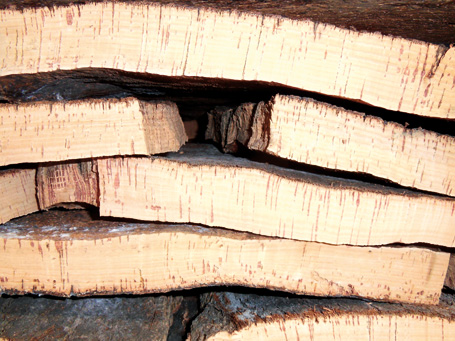
From Bark to Bottle
Cork harvesting The life cycle of cork as a raw material starts with the extraction of the bark from cork oaks, the so-called harvesting or stripping which is carried out during the most active stage in the annual growth of the cork, from mid-May or early June to the end of August. It takes between 25 and 30 years for a cork oak trunk to start to produce and be profitable. By this time, each trunk has to reach a circumference of 70 cm when measured at 1.5 metres from the ground.
The first stripping, which is known as desbóia in Portuguese, produces cork of a very irregular structure which is too hard to be easily handled. This is the so-called 'virgin cork' which will be used for applications other than cork stoppers (flooring, insulation etc.), since its quality is far from that necessary to manufacture stoppers.
Nine years later, the second harvest produces material with a regular structure, less hard, but still not suitable for cork stoppers - this is known as 'secondary cork'.
It is from the third and subsequent harvests (nine years later) that the cork with the best properties is obtained, suitable for the production of quality corks, since its structure is regular with a smooth outside and inside. This is the so-called amadia or 'reproduction cork'. From then on, the cork oak will supply good quality cork every nine years for around a century and a half.
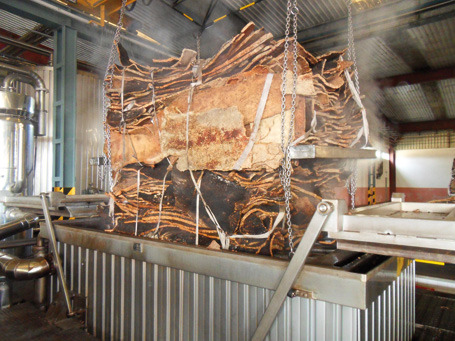
The stripping of the cork oak is an ancient process that can only (and should only) be done by specialists, the debarkers, since much manual skill and experience is required in order not to harm the tree. The stripping process consists of five steps:
1. Opening A vertical cut is made in the cork, choosing the deepest crack in the cork bark.
2. Separating The plank is then prised off the tree, by inserting the edge of the axe between the strip and the inner bark. The axe is twisted between the trunk and the cork strip to be extracted.
3. Dividing A horizontal cut defines the size of the cork plank to be removed and what is to remain on the tree.
4. Extracting The plank is removed from the tree with care so that it does not split. The larger the planks extracted, the greater their commercial value. The removal of entire planks depends on the skill of the workers. After the first plank has been stripped, the operation is repeated over the whole trunk.
5. Removing the base cork After the stripping of the planks, some fragments of cork remain attached at the base of the trunk. To remove any parasites in these “wedges”, the debarker gives them a few taps with his axe.
Finally, the tree is marked, using the last number of the year of the extraction.
After the harvest, the cork planks are stacked in piles either in the forest or in yards at a factory. There they remain exposed to sun, wind and rain during at least 6 months. All these piles are constructed taking into account strict specific rules (defined by the International Code of Cork Stopper Manufacturing Practice - ICCSMP), so as to allow the cork to stabilise.
Cork stoppers manufacturing
Boiling the planks Boiling is the process of immersion of cork planks in clean boiling water. They should be boiled for at least one hour. This treatment enables to disinfect and clean the cork, to extract water-soluble substances, to increase thickness and thus reduce density, and improve flexibility anBoiling is the process of immersion of cork planks in clean boiling water. They should be boiled for at least one hour. This treatment enables to disinfect and clean the cork, to extract water-soluble substances, to increase thickness and thus reduce density, and improve flexibility and elasticity.
Stabilisation of the planks
After the boiling, a period of stabilisation of the cork takes place. Only after this period, which lasts for two to three weeks, the planks are selected. Stabilisation serves to flatten the planks and to allow them to rest, in order to reach the necessary consistency for their transformation into cork stoppers.
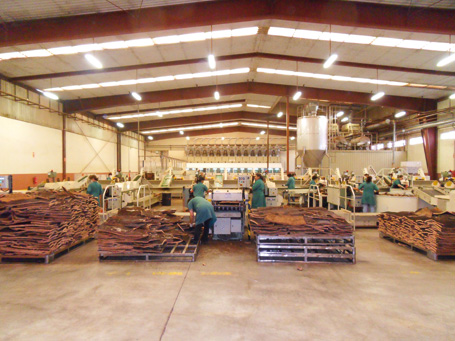
Slicing
After the stabilisation period, the cork planks are cut into strips slightly wider than the length of the cork stoppers to be produced.
Punching
Punching is the name of the manual or semi-automatic process of perforating the strips of cork with a drill. A cylindrical stopper is thus obtained within the prescribed dimensional limits.
All the wastes are used for cork granulate that will be processed to make technical stoppers (stoppers designed for bottled wines to be consumed within 2 to 3 years), or agglomerate products which are used as insulation and construction materials.
Visual rectification
After the punching, rectification enables to obtain previously specified final dimensions and to regularise the surface of the stopper.
Selection
This operation is designed to separate the finished stoppers into different grades, which are determined by automatic scanning of their surface. In some cases, the selection is done by visual inspection. During this stage, besides the definition of grades, defective stoppers are also eliminated.
Edifício Amorim
Rua de Meladas, 380 - P.O. Box 20
4536-902 Mozelos - Portugal
Tél. : + 351 227 475 400 - Fax : + 351 227 475410
www.amorim.comwww.amorimcork.comwww.amorimfrance.fr
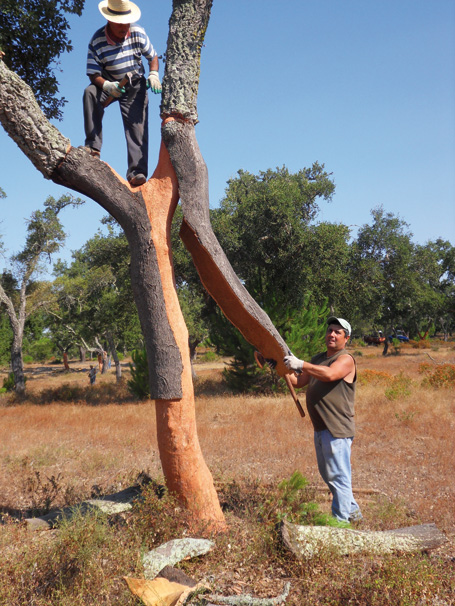
Cork stoppers finishing
WashingAfter rectification, the stoppers are washed using either hydrogen peroxide or paracetic acid. This cleans and disinfects the stoppers, but there are other methods also used such as microwaves or ozone. After washing/disinfection, the moisture level is stabilised, thus maximising stopper performance as a seal and simultaneously reducing microbiological contamination.
Colmation The cork stoppers may also be colmated. This operation seals the surface pores of stoppers (lenticels) with a mixture of cork powder produced by the rectification of natural cork stoppers. Colmation improves the presentation of stoppers that have many lenticels and helps to obtain a better seal.
 Printing or Branding
Printing or Branding This operation is carried out according to customers' specifications as to the type of marking to be applied. The methods used are ink printing (with food quality ink) or traditional heat branding.
Surface treatment After branding, the cork stoppers are given a paraffin or silicon surface treatment to make them easier to insert and extract from the bottles.
Packaging and transport Once their production is finished, the stoppers are packed in plastic bags with SO2 (sulphur dioxide), a gas that blocks microbiological proliferation. Only then will they be delivered to wine or spirits bottlers.
APCOR
APCOR is the Portuguese acronym for Associação Portuguesa de Cortiça (Portuguese Cork Association). It was created to represent and promote the Portuguese Cork Industry. It is an employers' association, of national scope, founded in 1956 and based in the North of Portugal, in Santa Maria de Lamas, a town just over half an hour from Porto. All the companies that operate in the fields of production, trade or export of cork products can join the
association.
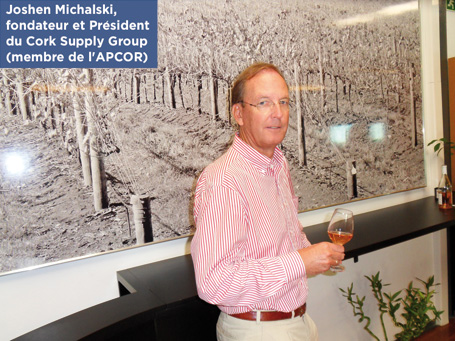
In conformance with the process of certification of the quality (ISO 9001) APCOR has for mission to represent and promote the industrial activities of the sector, by valuing the cork as a raw material of excellence, as well as all other products made from this noble material; by trying to create the conditions necessary for the development of industries which are associated members.
Group Amorim
A world leader
The Amorim family began producing natural corks in 1870, laying down the foundations of what became the biggest Portuguese and world group of the sector of the cork today. This long-time experience allowed Amorim & Irmãos to understand the whole manufacturing process of products stemming from the cork, from raw material to finished product.
The Amorim Group so holds a leading position on a national and international scale in the cork industry and the business still constitutes its largest core operation.
For over a century, the Amorim Group’s activity did not stop developing. It has expanded onto other business areas including real estate, tourism, telecommunications, textiles, and high quality natural sustainable products, such as Port and red wines. It also internationalized with in particular more than 31 production units worldwide.
However, the Group’s development has been built on a high degree of fundamental principles to ensure the sustainable growth of each investment: entrepreneurial strength, permanent innovation, long term strategic vision, robust finance, rigorous management and efficient resource allocation with a special emphasis on human resources.
The asset portfolio and operational structure of the Amorim Group was reorganized in 2005 with the business interests centered in the Corticeira Amorim and in the Amorim Desenvolvimento, a sub holding company intended to analyze and track new business opportunities.
AMORIM Group established in France in 1992. If the production of corks is still made in Portugal, AMORIM France, for its part, carries out the finishing (marking of corks, surface treatment), the packaging, the quality control and the delivery of products throughout the country, as well as Luxembourg.
The company possesses three industrial sites: Bordeaux, Reims and Cognac. This location, close to the production areas, allows AMORIM France to ensure great responsiveness and perfect adaptation to the needs of the French market, regardless of the customer profile: wine grower, merchant, cooperative…
Sales teams shared out between all major national vineyards are very close to their customers to guarantee full availability and ability to react.
AMORIM France joins in the approach for excellence introduced by producers and traders’ will to improve the quality of wines, in partnership with all of their suppliers. The company attempts to provide a quality cork, with particular care for surface treatments and marking, in order to keep all the product performance in terms of wine preservation and extraction of the cork.
Dominique Peyral-Bon
Le Groupe AMORIM en quelques chiffres:
- 31 production facilities in the world
- 18 industrial units
- Present in all wine-producing countries
- More than 3,000 people working for cork
- More than three billion closures produced annually
- A turnover of around 270 million euros.






